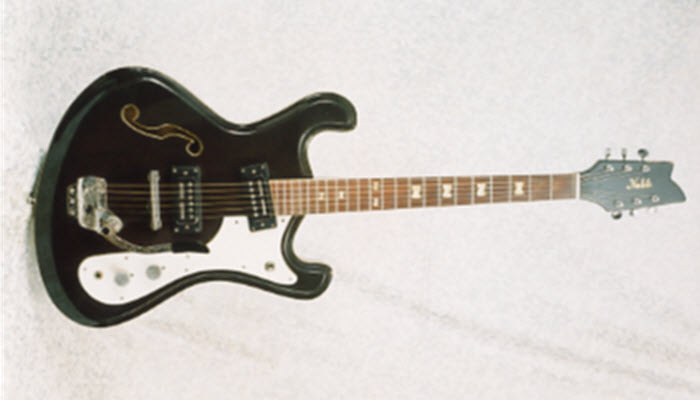
Guitar history has yielded some very odd marriages, from a business perspective, at least. While these can be found at almost any time, perhaps the glory days of unusual conjunctions was the 1960s, when cascading demand for electric guitars among maturing Baby Boomers caused corporations, both with and without music industry experience, to realize that thar’s gold in them thar hills. Among the odder of these unions was that between Chicago’s Heads & Threads company and Norma, Noble, and even National guitars.
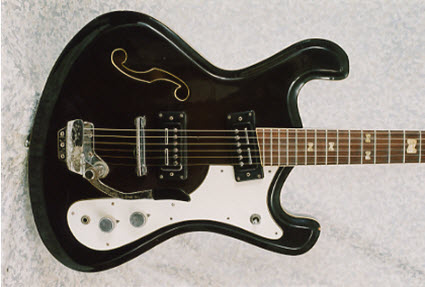
Vintage 1968 Noble EG 686-2HT Electric Guitar
How, you ask, could anything be odder than a beer conglomerate (Norlin) buying Gibson? (I guess, the more you think of suds and guitars, it’s not so hard to understand!) Well, that’s because Heads & Threads wasn’t about skin tensioners on percussion instruments or banjos. Heads & Threads was originally a pioneer in the importation of nuts and bolts made in Japan founded by Norman Sackheim. Please note his first name, the source of the “Norma” brand name. Like others before him (Jack Westheimer and sporting goods), it wasn’t such a giant step from hardware to guitars, given the times.
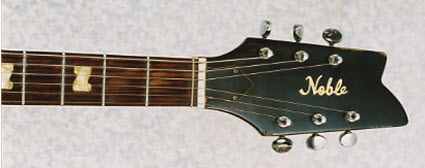
Vintage 1968 Noble EG 686-2HT Electric Guitar
Sackheim set up a subsidiary called, following a theme here, Strum & Drum in 1964 to import guitars and drums and related instruments. Like everyone else, Strum & Drum purchased instruments most likely from a trading company. They were the power brokers in Japan and every trading company had a stable of related manufacturers to draw upon, based on what the customer wanted. It’s darned near impossible to identify the makers of Japanese guitars with any precision. Sometimes outstanding workmanship—as in the cases of Matsumoku or FujiGen—are pretty compelling evidence, but there were so many specialty providers (eg, hardware, pickups, etc.), it’s hard to identify conclusive features. This is further complicated by the fact that imitation of successful ideas between companies was an accepted part of the culture, so just because something looked good on one brand’s product doesn’t mean it wouldn’t show up on another’s. Welcome to reality!
That said, the majority of Strum & Drum’s electric guitars seem to have been sourced from the Tombo factory. A few have features that suggest Teisco, with the caveat above. There’s no way to know where the acoustics came from. The older I get, the less important that seems to get, but I also know we collectors have issues…
Norma was Strum & Drum’s major brand. Many were pretty pedestrian solidbody and hollowbody electrics that are interesting as period artifacts, and little else. Of special interest were their sparkle-finished guitars, which are about as cool as it gets with ‘60s Japanese guitars.
In 1966, Norm Sackheim’s son Ron bought the rights to Don Noble’s instrument line. Noble was a prominent Chicago-area accordionist who sold imported accordions and guitars. Some Noble guitars made by Wandré Pioli in Italy appeared, but in ’67 the line was cancelled and the Noble name was added to the Strum & Drum stable.
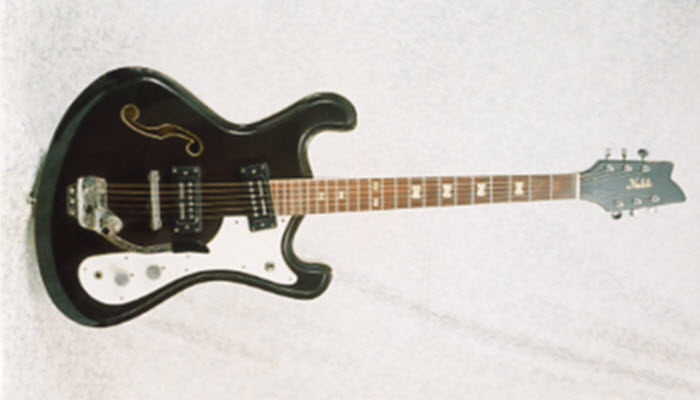
Vintage 1968 Noble EG 686-2HT Electric Guitar
While all this was transpiring, the Ventures were becoming guitar gods in Japan, and Japanese makers began to build Mosrite “copies.” Long story short, the Noble brand re-appeared on some Mosrite copies sold by Strum & Drum, including this 1968 copy of a Mosrite Combo hollowbody, The Noble Model No. EG 686-2HT.
I’m no Mosrite expert but I own a Combo and this copy isn’t too far off in terms of quality. Mosrites weren’t that great. And, it’s pretty historically interesting. Note the nifty “N” fingerboard inlays and real German-carve top. This guitar was the only Noble model, the only Strum & Drum Mosrite copy, and was only available until late 1969, maybe into 1970. Ironically, The Noble Mosrite Combo copy is probably as rare if not rarer than a genuine Mosrite. Such a world; go figure.
In 1969 Strum & Drum bought the rights to the National brand name—notice the N theme—and brought out the National Big Daddy, one of the earliest bolt-neck Gibson Les Paul Custom copies, in 1970, but that’s another story. Strum & Drum stumbled on into 1975 when it was sold to C. Bruno, who promptly deep-6ed the whole shebang. Seeing promise in the nuts and bolts market, the Sackheims returned to importing those essentials, which they were still doing the last time I spoke to them quite a few years ago. So, that’s what nuts and bolts—or Heads & Threads—have to do with our favorite obsession, and some venerable brand names in guitar history.

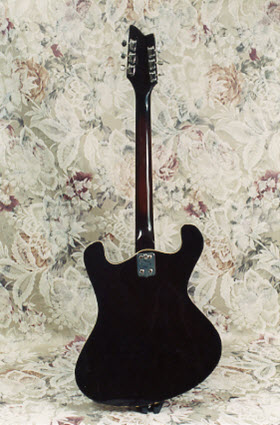
“Mosrites weren’t that great.”
Finally, it’s been said. Truth or blasphemy? The guitaristas will opine…
A very enjoyable article, Michael. I want to say thanks for the fine stories you have told of the history of guitars. I own three Matsumoku made guitars, and I love them for how well made, and subsequently how playable, they are.
All the best to you,
Jeff Jaeggi
Great Article!
It is good to see someone who will stand up for a well-built instrument regardless of where it was made. When I was learning to play in the 60’s , Japanese guitars were considered junk. Period. Anything U.S. made was o.k., regardless of quality. Now, admittedly, some Japanese guitars of that period WERE crap. Plywood fretboards, questionable electronics, etc. However, many were as well built, if not better built and sounding as good or better than U.S. counterparts costing many times more. It’s also nice to read that someone has the GUTS to say that some of the U.S. Holy Grail brand names, well, maybe, weren’t really built that well. As an example, I own a Matsumoku teardrop bass (Raven) as well as a Vox from the same period. Frankly , the Raven blows the Vox away in terms of sound, playability and overall construction. It is simply a better bass. And yes. I know that Vox wasn’t made in the U.S. Anyway, great article!!!
I’ve got one of these Nobles, it’s about the best guitar I’ve got yet paid the least for. I think the one pictured here has the wrong bridge, they came with a Mosrite-style bridge that had plastic rollers.
It is just so refreshing to read an article about cool wonky looking 60s gits and not have one single damn reference to Ry Cooder , Jack White or Dan Auerbach rear its’ ugly head.
Damn it now I have… damn !!
Great article. I had my eye on one of these guitars and was on the fence about purchasing it until I read this article. I guess it’s a bit more rare than I thought and could actually be a player. Thanks for all the great info
Don
I bought one of these Noble guitars in Seattle from a discount place called House of Values in 1969 for about $75.00. I had gotten a Teisco from Gov-Mart in 1966 from my parents for Christmas (after much begging). It was a wonder I didn’t give up playing it was such a pain trying to tune it. Much later figured out that the bridge had been placed incorrectly.
Anyway I saw that Noble and fell in love. I went and sold my mini-bike I had built to help pay for it. It has the BEST neck of any guitar I have ever played and never goes out of tune. I have a number of guitars and basses now, but my Noble is VERY special to me.
I thoroughly enjoy this website! I own several Fenders, Gibsons and Valley Arts strats. Good guitars all. But let me tell you, in my humble opinion of having played now for 40 years, one of the best bargains still to be had in older ‘vintage’ guitars are some of the Japanese Matsumoku plant manufactured guitars. I own a bunch! I’m telling you now…their day is coming soon-the day when they are sought after for being the gems they are.Vantage, Electra, Westone, Aria, Aria Pro II, Memphis, Westbury, Westminster, several models of Epiphones, and Skylarks (sold by JC Penney).
Some of my Japanese Matsumoku made Electra’s, Aria Pro II’s and Westone’s are superb quality instruments. I truly have to chuckle at the prices they can still be found for if you are just a little patient and dedicated to the search. I wish I could post pics for you.
Thank you so much. I found one at a fleet market yesterday. It screamed at me from across the room. I couldn’t stop looking at it , it’s odd shape and oversized features were so breath taking but the price tag was more overwhelming. After reading this article I’m proud to say that it’s now one of my favorite posesions
Thank you so much for this article. I purchased this guitar 20 years ago for $20 at a neighborhood flea market, and I’ve never been able to find any information on it. I figured that it was some sort of Mosrite copy, but that was about it. Anyway, it’s got a really glassy high end and that P90 “honk”. It’s pretty cool. Mine has that Bigsby style bridge too.
What are these Noble 686 2HT electric guitars worth I have one for sale
How. Much. Is. A. Noble.
Eg 686-2 ht. Guitar. Worth.
Good. Condition. ?
where might I find a wiring diagram for a Noble 4 pickup solid body with rocker switches?
thanks